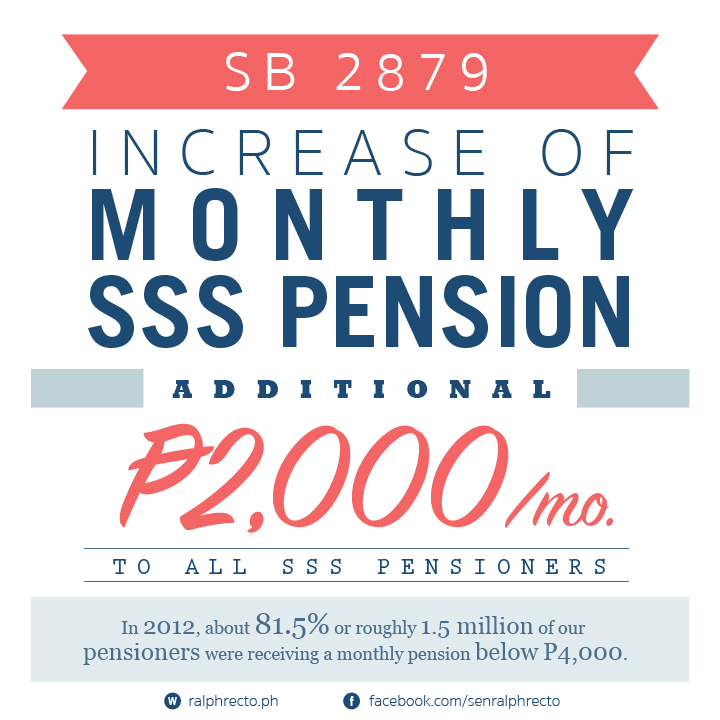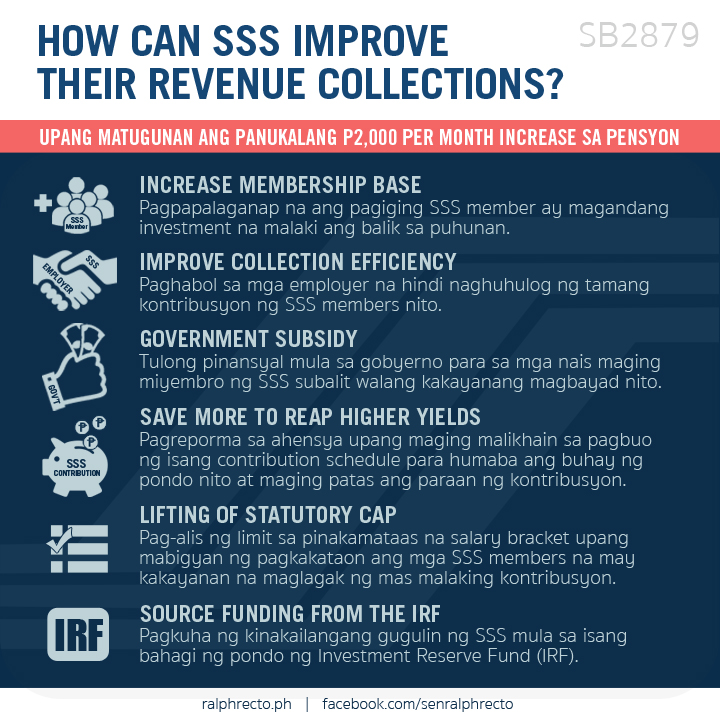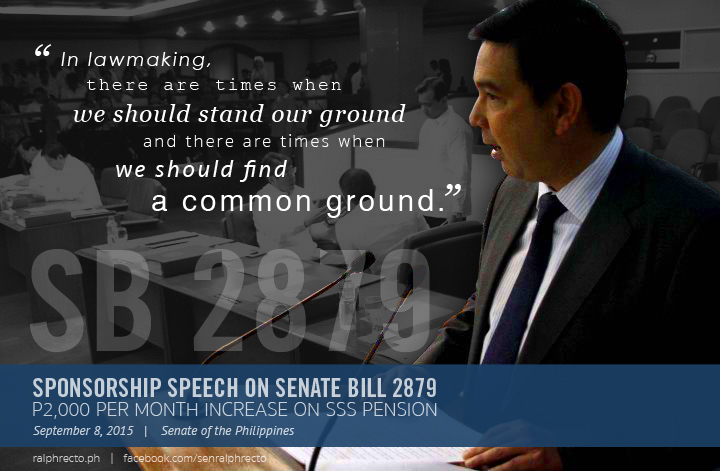Sponsorship Speech on Senate Bill No. 2879
Mr. President:
If people will be quizzed on what’s that government building along East Avenue in Quezon City with so much money, those in the know will most probably answer: the Central Bank Mint.
But there’s another office across it that is also awash with cash – the Social Security System (SSS).
There is, however, a big difference on how they were able to hoard cash. The Central Bank merely prints money, while the SSS pools it from the contributions of its members.
If there is one trait that these institutions share, it is how they guard their coffers. The BSP is ringed by armed guards, a deep moat and a tall fence. The SSS, protected by stewards who exercise vigilance so that its funds would not go dry.
Which means that while over at the BSP compound, bales of paper bills are forklifted onto armored vans for distribution, the sentinels at SSS are conservators who calibrates the release of benefits carefully.
And so they should.
Why? Because social security pension is long term savings paid one pay day at a time.
If it is a safety net for old age, sickness, or disability, then the strings are woven by installment through mandatory salary deductions.
Or you can call these contributions a generational time deposit, one that will be redeemed after the present generation of workers has retired from work.
The kind of nest egg a member can look forward to when he finally comes home after decades of labor – and battling traffic – and hollers to his wife – “Honey, I’m home – forever.”
Kaya wala naman talagang forevermore sa pagbabayad ng SSS contribution. Or to borrow a line from a song popular a generation ago – hindi ‘yan pag-aambag “hanggang sa dulo ng walang hanggang.”
The SSS contribution is a payroll tax. But unlike conventional taxes, it is inflicted on both the employee and the employer.
And as a tax, its payment is compulsory in nature, which is why it is withheld at source, and its evasion, if done by an employer, sanctionable.
Under the current scheme, every one peso plunked in by the employee is matched by his employer’s share of two pesos.
So an employee who earns P16,000 a month contributes P1,790 monthly to the SSS – P582 out of his pay, and P1208 out of his boss’s profit.
On paper, there are 32.5 million SSS members who fork over their one-third share monthly. And 921,825 employers who give their two-thirds equity.
But according to the SSS, only one-third, or between 10 to 11 million, of its 32.5 million registered members are paying.
The rest, or about 21 million, are either in arrears, or have abandoned, or have developed amnesia on their social security obligations.
Yet, they were able to remit P120.6 billion in contributions last year.
But SSS does not merely amass money, it apportions them. It shares what it stockpiles.
Last year, it paid out P102.6 billion in benefits.
Of this amount, the largest chunk – P89.5 billion – went to the system’s 1.9 million pensioners.
The rest, or about P13.1 billion, was spent for maternity benefits, death benefits and burial assistance claims.
Because SSS is a cradle-to-grave aid provider, then it is possible for a member to get help from it, from his first cry to his last breath.
And indeed, many were born into this world by mothers in SSS-paid maternity wards and sent off courtesy of an SSS-paid service.
But this bill deals with life between these two milestones. Specifically, the period when a member has to enjoy the fruits of his contribution.
So today, I plead the cause of 1.9 million SSS pensioners, those who have come before us and worked hard so that we may have a better life.
At their peak, they were productive workers. Freeloaders they were not.
What they are getting now from the SSS are not entitlements they had no participation in raising. It is made possible not by the grace of the state, but by the grit of their work.
They amortized their contributions, religiously every pay day, in the hope that what was deducted from their take home pay today would take them to a comfortable life one day.
In 2012, about 81.5 percent or roughly 1.5 million of our pensioners were receiving a monthly pension below P4,000.
This is less than the daily minimum wage and certainly below the poverty line.
Today, P4,000 pesos can barely stock the medicine cabinet with drugs, much less the cupboard with food.
Our elderly survive as much on a cocktail of medicines – from simvastatin to tame elevated cholesterol, to beta blockers to deflate high blood pressure, and metformin to control their blood sugar level – as on consuming healthy calories.
Yet while their sugar level rises, the value of the pension they receive from which they get the money to bring it down decreases.
According to a report, the value of P1,000 in 2000 has since gone down by 43 percent.
Rice then was P20 a kilo, beer was P10 a bottle.
And the true value of P10,000 in 2010 is about P8,000 today. The erosion of the purchasing power courtesy of that known culprit called inflation.
Thus, it is not only that the pension has gone down the slippery slope, those who receive it are hanging tenaciously on that slope too.
Unless, to prevent their fall, we give them a helping hand.
How? By increasing their pension, and saving them from the abyss of unfathomable misery.
Which is why on the first week of the first month of the first regular session of this Congress, I filed Senate Bill 451, which provides for an increase in SSS pension.
My bill has been consolidated into Senate Bill 2879, the one on the floor today.
The consolidated bill seeks an across-the-board increase of P2,000 on the monthly SSS pension.
In effect, those receiving the minimum pension of P1,200 per month will now receive P3,200 under this bill.
The average SSS pensioner gets about P3,169 a month. If this bill becomes law, his pension will increase to P5,169.
Of course, this bill carries a price tag, estimated at P48 billion annually.
It can be viewed narrowly as a cost or seen as 48-billion-peso boost to the purchasing power of our elderly.
They will not put this under their pillow but plow it back to the economy. They may have many ailments but, unlike government, underspending is not one of them.
In fact, chronic lack of money to spend is what boggles them.
There are concerns that raising pension payouts will lead to the early evaporation of SSS money.
This is a valid point but I do not subscribe to the doomsday scenario likening the increase in pension to blasting a hole underneath a water tank.
With regard to funding the higher benefits, increasing its membership base is among the most plausible solution to improve revenue collections.
One estimate pegs at only 30 percent the number of employees who ought to be SSS members under the law.
In other words, 70 percent of potential members are not captured by the system.
Although they cannot be compelled to be members, I believe we can raise social security compliance by marketing SSS membership as an investment instrument with a high ROI.
Expanding the base is essential to its sustainability. The more active worker per pensioner, the healthier the books of a pension system is and the brighter its future would be.
Actuarial longevity of any pension hinges on a good worker-pensioner ratio.
For those already in the system, the SSS must take a hard line position against those who violate the required membership registration.
It must run after employers who run away with their employees’ membership contribution.
In fact, theoretically, improving its collection efficiency can even result in lower contribution schedule for members.
The SSS can also consider seriously other forms of investments in order to increase its revenues from its investible funds as may be allowed by its charter.
Another pathway is government subsidy.
Should this be resorted to, I believe one option is to subsidize the membership of the marginalized members of society who are still outside the system because they have difficulty paying their SSS contribution.
It is not orthodoxy to suggest that government help can come in on the other end, from the intake of contributions instead of the outtake of benefits.
Lastly, in order to provide the present pensioners better benefits and at the same time ensuring that the future retirement benefits of current members will be at a better rate, the SSS can institute structural reforms and be more creative in devising a Contribution Schedule in order to increase the fund life and introduce a more equitable contribution scheme.
For those who want to contribute more, they should be allowed to do so.
For those who want to save more, so they would reap higher yields, they should not be prevented from doing so.
At the moment, there is a statutory cap in the computation of the monthly contribution pegged at the maximum of P16,000 monthly salary credit.
Hence, salaries higher than this amount are required to contribute the same amount of P1,790.
Under the present scheme, a clerk who earns P16,000 monthly will have a contribution of P1,790 monthly or 11 percent of his salary, while a manager, for instance, with a salary amounting to P90,000 will also have the same contribution of P1,790 or only 2 percent of his salary.
The SSS contribution is considered a payroll tax; however, its schedule does not mimic the features of a progressive tax system
The SSS can therefore consider lifting the cap on the highest salary bracket and design an optional contribution schedule such that those receiving higher salaries can have the option to contribute a higher percentage of their salary.
Another option is to source the funding requirement from the IRF, the Investment Reserve Fund, which stands at about P450 billion.
I am not saying that this will solely fund the deficit. The required outlay can have multiple funding sources – from membership expansion to even trimming management overhead to IRF.
Though I would caution against massive drawdowns from the IRF to fund the pension increase, I take the position that getting a reasonable amount from the IRF is not a sacrilegious idea even by those who worship an extreme form of pension management.
Mr. President:
The executive has gone on a full-court press to stop this bill. Through various means and emissaries, it has signaled its intention to veto this bill.
My advice to them is that instead of plainly saying no, it should offer some alternatives, solutions even on how to fund the increase in the long-term.
In lawmaking, there are times when we should stand our ground, and there are times when we should find common ground.
The last one entails manifesting openness to an idea, instead of automatically shooting it down. The executive should abandon its “no increase” stand. Its inputs should not be solely confined to immoveable opposition but engagement to find that common ground.
Let us challenge the SSS to study the details of the above proposals.
The SSS, considering its actuarial status, will effectively have more than a decade to figure out how to cope with this proposed increase in benefits.
On the other hand, our poor pensioners cannot wait a day more for better benefits so that they may survive.
Increasing the monthly pension of those who spent the best years of their lives paying the SSS payroll tax so they can be comfortable in their last years will show them that we care.
If the economy is good as they claim it is then perhaps they who worked hard to make the prosperity we now enjoy possible deserve bigger dividends.
But this bill is not driven by pure sentimental stuff alone. It is anchored on studies that such an increase is feasible and fundable
Mr. President and my dear colleagues :
This is not a long sponsorship speech for a significant bill. After all, measures that increase benefits to the vulnerable are self-explanatory and do not need elaborate justification.
I earnestly appeal for your support to the passage of this bill.
Maraming salamat po!




